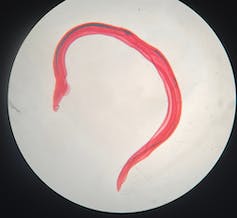
Cell membranes make up the exterior of all cells and are a basic structure found in most living organisms. But they can also help parasites survive in the human body, play an important part in cancer growth and enclose and protect deadly viruses, including the one that causes COVID. Scientists are looking to understand how bilayers (cell membranes with two layers) work and whether they can be used to develop new drugs to combat infections.
It has been known for a long time that living cells are enclosed by a fatty layer that separates different cells. This can be clearly seen in red onion skin cells in which the dye that gives the onion its distinctive colour is confined in these layers. Building on previous work, Seymour Singer and Garth Nicolson suggested a structure for this layer in 1972 which they called the fluid mosaic model.

Jiang Hongyan/Shutterstock
Their model has since been found to explain many features in living organisms. The bilayer is even part of the structure and function of many viruses such as influenza and SARS-Covid-2. Viral particles can use it as a protective layer which helps them to spread. For example, we can trace how a viral particle of SARS-Covid-2 enters a lung cell and what happens next.
When one of these viral particles enters a lung cell, it releases its ribonucleic acid (RNA) – single-stranded genetic code. This translates into viral proteins on ball-like structures called ribosomes that are attached to membranes inside the host cell. These viral proteins are then transported to another part of the cell called the Golgi apparatus which encloses them in lipid (fatty) bilayers. They then make a further journey, fusing with the surface membrane of the cell, before leaving it altogether – a process known as exocytosis.

Ralf Geithe/Shutterstock
When the virus leaves the cell it carries some of the membranes from the host cell with it. And the virus – now carrying a protective coat – will attempt to infect another lung cell or be released into the air as we breathe or cough.
Disrupting the virus
Biochemists in a team led by Valerie O’Donnell at Cardiff University are trying to find out more about this bilayer with the hope that drugs could be designed to combat the virus itself. By growing the COVID virus in the laboratory and extracting the lipid from it, they have found that its surface membrane is very different from that of the host surface membrane – it has much less cholesterol and sphingomyelin (a fatty lipid component) and many more lipids which can increase blood clotting.
When we look at the way the virus acquires its membrane, a number of drugs might be used to disrupt its pathway. This has been done before. Scientists working with tubercle bacilli in the 1950s showed that certain harmless detergents disrupted the tuberculosis infection they cause. With COVID, widespread handwashing, using hand sanitiser and mouth washing attacked the virus’ bilayer and destroyed it.
Perhaps the virus will produce, by mutation, a new strain that has a tougher bilayer. The Cardiff laboratory is looking into the lipid composition of different strains and the results may indicate novel pathways for evolution of viruses and their treatment.
Other roles for bilayers

Mohammed_Al_Ali/Shutterstock
Bilayers are also involved in the infection of humans by diseases such as schistosomiasis (also known as bilharzia). Infective larvae swimming in water penetrate human skin and the bilayer on the larval surface immediately changes to a unique double layer to allow it to survive in human blood. The larvae then covers itself with lipids from this blood and scientists have suggested that this disguises the membrane from the immune response of hosts – in other words, us.
Another hypothesis put forward by scientists in Egypt about the toughness of this double bilayer comes from the amount of sphingomyelin, which they found protects the membrane by forming hydrogen bonds at the surface. This is thought to prevent access to immune antibodies and cells. Reducing the amount of sphingomyelin with arachidonic acid – a fatty acid found in the body and also used in some supplements – can act as a drug against the disease. It is usually used in combination with another drug called praziquantel which attacks the parasite’s membrane.
One exception to the generalisation that bilayers are in all living cells are the parasitic and soil nematodes. Enormous numbers of these are found in soil: ones that do not affect other plants or animals such as Caenorhabditis, but also numerous other animal and plant parasitic species in the tropics and temperate zones. These organisms have a surface in which lipids are thought to be arranged in unusual hexagonal structures to form large rafts which give an alternative structure to the bilayer found in most cells.
Study of lipids can surprise us and lead to new ideas about life and its structure, but also, excitingly, towards drugs that can be developed to disturb the structure of the lipid membranes of pathogens, cancers and other human infections.
![]()
John Kusel does not work for, consult, own shares in or receive funding from any company or organisation that would benefit from this article, and has disclosed no relevant affiliations beyond their academic appointment.






















